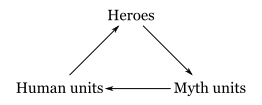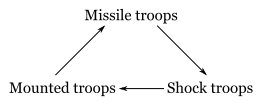Combat in Age of Mythology
In my most recent blog post for Ancient Warfare, I wrote about why armies tend to consist of different types of fighters, and drew a comparison with the rock, paper, scissors dynamic found in strategy games such as Age of Mythology. After we recorded the latest podcast (on issue IX.1, the fall of Rome), Angus Wallace and I talked for a bit about Age of Mythology and I thought it would be interesting to devote some words to the game here.
If you’re interested, you might also want to check out my earlier series of blog posts on ancient warfare in videogames (part 1, part 2, and part 3).

Anyway, Age of Mythology was released in 2002 and is a spin-off from the Age of Empires series. The game takes place in a sort of parallel universe, where mythology is real and where Bronze-Age Egyptians exist alongside Classical Greeks and the early Norse. The main hero of the single-player campaign comes from Atlantis, so it’s clear straight from the get-go that this isn’t meant to be a historically-accurate game.
However, the designers seemed to have done their homework and while the game isn’t historically accurate by any stretch of the imagination, it does feel authentic (I’ve written on the distinction between accuracy and authenticity before, as in this blog post on Greek mythology on screen). More importantly, the game itself is excellent as far as its mechanics are concerned. It’s a real-time strategy game with three main factions: the Greeks, the Egyptians, and the Norse. The expansion pack adds the Atlanteans – which are very similar to the Greeks – and introduces Titan units, which are – you guess it – gigantic in size.
The basic game adheres to all real-time strategy tropes: you harvest resources to build structures, and you use the structures to train (recruit) and upgrade your military units. Age of Mythology also uses a rock, paper, scissors scheme when it comes to unit relationships, but adds a layer of complexity. All units are essentially divided into three types: heroes, mythological units (e.g. monsters and the like), and human units. The relationship between these three can be summarized as follows:

Heroes are strong against mythological units, which in turn are strong against human units, and humans are strong against heroes. This works because it seems to fit with our knowledge of myths: heroes are great monster-slayers, but they can still be defeated by ordinary humans. Humans fear monsters and other mythological creatures and rely on heroes for their defence.
Within each category, the normal relationships mentioned in the earlier blog post apply. I will include the diagram again for convenience:

In other words, an archer beats a hoplite, who in turns beats a horsemen, who in turn is excellent against archers and other missile troops. Within the context of Age of Mythology, this applies to human units, but also to mythological units and to heroes. For example, a ranged monster will defeat a melee-focused monster.
Age of Mythology adds some more complexity through its use of different types of armour and damage. There are three types: crush, hack, and pierce. Pierce damage is caused by missiles, while hack damage is caused by swords and other melee weapons. Crush damage is caused by siege weapons only, and thus most regular units have 99% crush armour (meaning that only 1% of damage is inflicted per hit when a normal unit is attacked by a siege unit). In Age of Empires III, which is modelled to a large extent after Age of Mythology, these different types of armour and damage were renamed to simply siege, melee, and ranged. They operate in the same way.
Siege weapons, such as catapults, are strong against buildings, but very weak against almost any other units. This echoes history, of course, and explains why you would always have to protect your siege units from enemy attack: a group of enemy horsemen would make swift work of your siege engines, and that would be a waste of time and resources on your part. (Rise of Nations offers better grouping of armies and if you alt-right-click on an enemy city, your siege engines will attack it while the rest of your army forms up in a defensive position.)

Age of Mythology is a great game and one of my favourite real-time strategy games. A revamped version of the game was released in 2014 as Age of Mythology: Extended Edition and is available on Steam (as is the equally great Rise of Nations: Extended Edition, by the way). The game frequently gets a discount, so it pays to be patient if you’ve never played it before and want to pick it up.
